
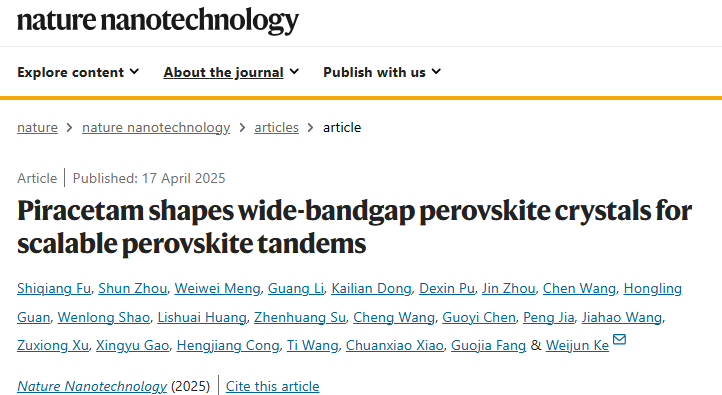
【Research Background】
Perovskite materials have become ideal choices for next-generation photovoltaic materials due to their excellent optoelectronic properties and low-cost manufacturing processes. They are widely used in solar cells, photodetectors, and light-emitting devices. Compared to traditional silicon-based materials, perovskite materials offer significant advantages such as higher light absorption efficiency, broader spectral response, and lower processing costs. However, perovskite solar cells (PSCs) still face numerous challenges, especially in the application of wide-bandgap perovskite (WBG) materials, including poor crystal quality, phase separation phenomena, and device stability issues, which severely limit their efficiency and commercial application for large-area devices.
In this context, Professor Ke Weijun’s team from the School of Physics Science and Technology at Wuhan University published a paper titled “Piracetam shapes wide-bandgap perovskite crystals for scalable perovskite tandems” in the journal Nature Nanotechnology. They designed and prepared a crystal modifier—piracetam—specifically to improve the crystal structure and optoelectronic properties of wide-bandgap perovskites. The team significantly increased the grain size and crystallinity of perovskite films using piracetam, resulting in excellent optoelectronic performance and successfully addressing common issues such as surface roughness and non-uniformity in large-area devices.
The research demonstrated that through the modulation of piracetam, the researchers not only promoted the preferential (110) crystal orientation of wide-bandgap perovskites but also formed one-dimensional (Pi) PbI3 perovskite nanoneedles at the grain boundaries through reaction with PbI2, further reducing defects and enhancing the optoelectronic uniformity and stability of the films. Ultimately, the research team successfully achieved high power conversion efficiency (PCE) for large-area all-perovskite tandem solar cells (TSCs). For small (0.07 cm²) and large (1.02 cm²) area devices, they achieved PCEs of 28.71% (certified 28.13%) and 28.20% (certified 27.30%), respectively, with a PCE loss of only 0.51% between small and large area devices.
【Research Highlights】
(1) The experiment first introduced the crystal modifier piracetam to regulate the nucleation process of wide-bandgap perovskites, resulting in large grain sizes, preferential (110) orientation, and uniform optoelectronic properties.
(2) The experiment formed one-dimensional (Pi) PbI3 perovskite nanoneedles at the grain boundaries through the reaction of piracetam with PbI2, significantly enhancing the crystallinity of the perovskite, reducing defects, and improving the smoothness of the grain surfaces.
(3) The experiment successfully improved the performance and reproducibility of large-area all-perovskite tandem solar cells (TSCs) by regulating the grain growth and optoelectronic properties of WBG perovskites, achieving PCEs of 28.71% (certified value 28.13%) and 28.20% (certified value 27.30%) for areas of 0.07 cm² and 1.02 cm², respectively.
(4) The experiment optimized the homogenization process of WBG perovskites, achieving high energy conversion efficiency for large-area TSCs, demonstrating the broad applicability of this method across different perovskite compositions, and increasing PCE from 23.56% to 25.71% for single-junction 1.56 eV bandgap solar cells.
【Visual Interpretation】
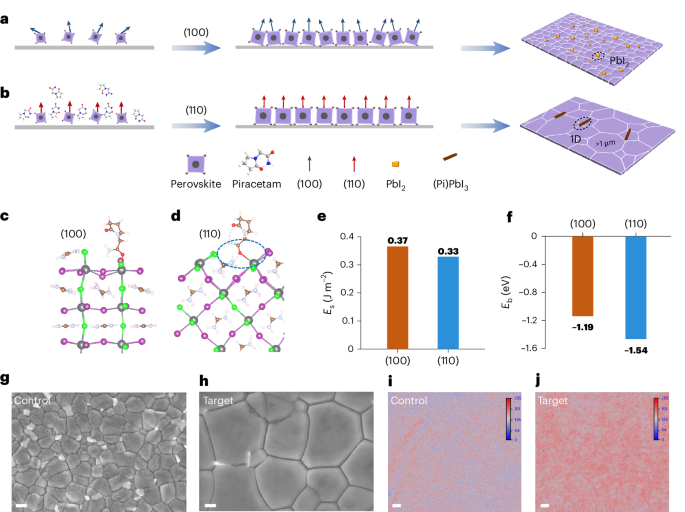
Figure 1: Schematic of the effect of piracetam on wide-bandgap perovskites.
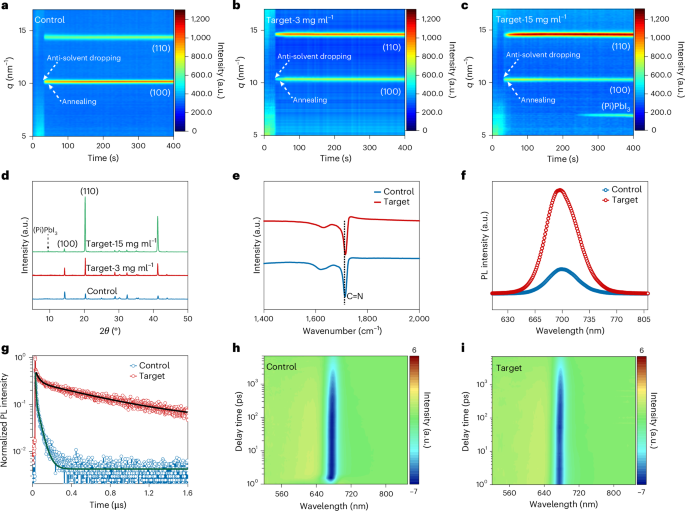
Figure 2: The impact of piracetam on the crystal structure of wide-bandgap perovskite films.
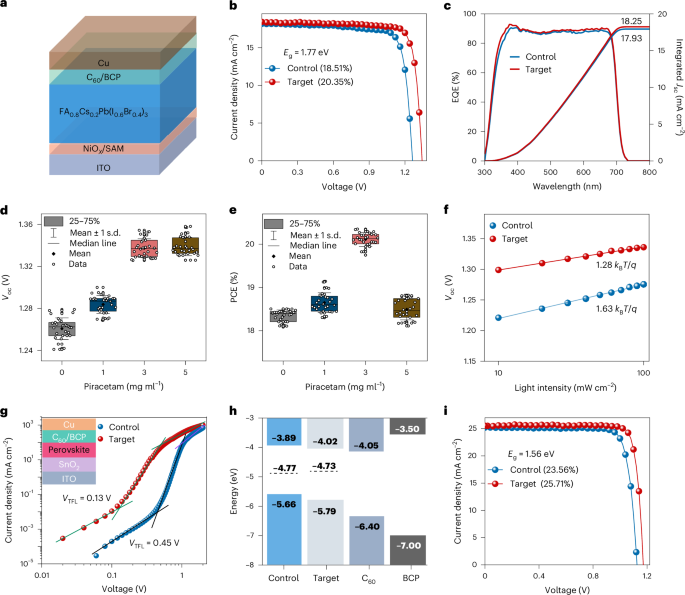
Figure 3: The effect of piracetam on all-perovskite tandem solar cells.
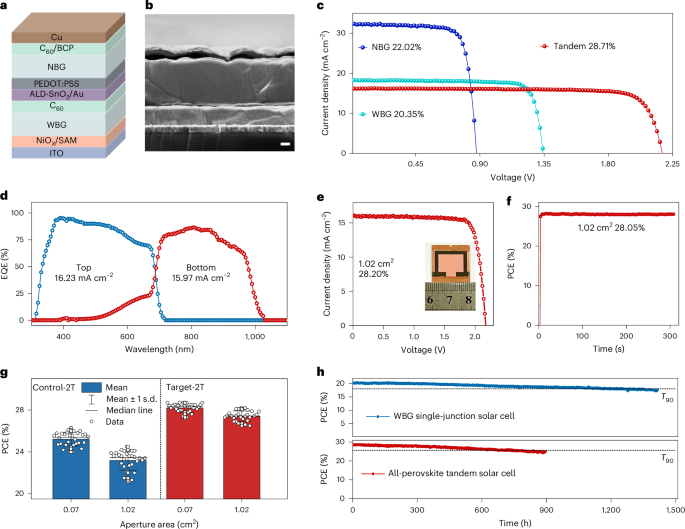
Figure 4: Performance of 2T all-perovskite tandem solar cells.
【Conclusion and Outlook】
In summary, this paper demonstrates the effectiveness of piracetam as a crystal modifier, achieving high-quality wide-bandgap (WBG) films with preferential orientation, reduced defects, improved crystallinity, and ultra-smooth surfaces. Furthermore, one-dimensional (Pi) PbI3 perovskites were formed to further enhance device performance. This method significantly reduced the open-circuit voltage (Voc) loss and greatly improved the power conversion efficiency (PCE) of wide-bandgap perovskite solar cells (PSC) and all-perovskite tandem solar cells (TSC).
It is noteworthy that the introduction of piracetam minimized the efficiency gap between small-area and large-area tandem devices, achieving PCEs of 28.71% (certified value 28.13%) and 28.20% (certified value 27.30%) for 2T all-perovskite TSCs in areas of 0.07 cm² and 1.02 cm², respectively. Despite these advancements, challenges remain for large-area tandem modules, particularly regarding phase separation and ion migration. Further progress requires the adoption of Br-reduced WBG sub-cells, NBG sub-cells without PEDOT:PSS, robust tunneling layers, and scalable deposition techniques, combined with advanced interface engineering strategies to drive the continued development of all-perovskite tandem technology.
Original details: Fu, S., Zhou, S., Meng, W. et al. Piracetam shapes wide-bandgap perovskite crystals for scalable perovskite tandems. Nat. Nanotechnol. (2025). https://doi.org/10.1038/s41565-025-01899-z
